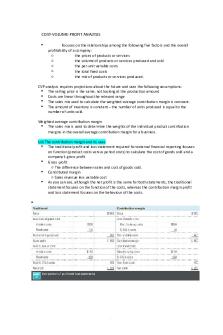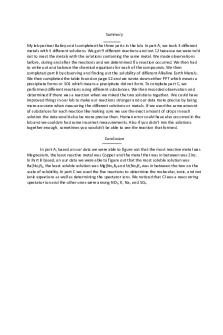Chapter 5 - Conclusion or summary PDF

| Title | Chapter 5 - Conclusion or summary |
|---|---|
| Author | Kirupalini Krishnan |
| Course | Bachelor Disertation |
| Institution | Universiti Putra Malaysia |
| Pages | 7 |
| File Size | 89.7 KB |
| File Type | |
| Total Downloads | 9 |
| Total Views | 137 |
Summary
Conclusion or summary ...
Description
CHAPTER 5 DISCUSSION, IMPLICATION AND CONCLUSION
5.1 Introduction This chapter sets out the findings and discussions, proposals and recommendations for further research and formulation. It focuses on reviews, opinions, and recommendations of researchers. In this chapter will also set out a brief discussion of research methods, research tools, and sample and data analysis methods used.
5.2 Discussion In this research, the test that researcher applied is correlation which identify the relationship between four variable. In this research researcher had figured out, three independent variables and one dependent variable. The four independent variables include school education, interest, student attitude and current CGPA. The dependent variable is student performance in introductory of accounting.
5.3 Summary of Research Methodology The main purpose of this research is to find about factors that affects student performance in introductory of accounting. This study also aims to find the relationship between the school education, interest, student attitude and current CGPA. This research also investigates the student performance in introductory of accounting among difference major programs (non-accounting) such as Business studies, Chemistry, Human resource, Food service management and Petroleum
chemistry. A total of 100 students in University Putra Malaysia has involved in this study. Hermanson and Hermanson (1995) state that attracting the "best and brightest" business students to the accounting profession is becoming more and more difficult. The following possible reasons for this issue are given by Garner & Dombrowski (1993), quoted in Hermanson & Hermanson (1995): provides the following possible reasons for this issue such as students are attracted to more immediate rewards and responsibilities in other fields, Litigation and personal liability made the professional less attractive, starting salaries in public accounting are too low and other areas of business appear more exciting or important than financial accounting. Since academics, professionals, accounting societies, organizations, and some other related parties have realized this quality issue in accounting education, they have tried to find some solutions (Elfrink & Woodruff, 2008). Cohen & Hanno (1993), for example, states that accounting education must also focus on attracting and retaining high - quality students to accounting as an academic major in order to produce graduates with the desired skills and abilities.To achieve this goal, they make some recommendations such as the following such as the beliefs and factors influencing students choice of academic major need to be identified. Success in introductory courses facilitates the selection of accounting as a major. The restructuring of the accounting curriculum should therefore be targeted at the courses of the foundation.
5.4 Implication of Study
This section will give a full picture of the implications of the study. This study extended a research line that attempted to understand and explain students ' performance in the introductory of accouting course. This study provides some unique contributions to the literature. Using samples, multiple models, and comparing those students who majoring in different courses helped to assess the consistency of predictor variables over time, across models, and across groups. The results of this study are largely consistent with previous research. A student current CGPA and performance in introductory of accounting were found to be most powerful and significant predictors of performance. In addition to exploring a number of important variables from the preceding literature, the study refined, tested the validity of and examined the incremental contribution to accounting attitudes towards student performance. It has been found that the attitudes of students towards accounting in terms of conceptual and practical aspects are empirically different. The unique and rather consistent patterns of certain student attitudes within student subgroups suggest that it may be worth further work on student attitudes. In particular, students ' self - selection in their accounting study indicates that there are specific biases that may be useful for further exploration. The inconsistent pattern of school education's influence in accounting and other studies suggests that something about accounting school education may affect the outcomes, but that the nature of it has not been sufficiently captured in measures to date. Also, the results of this study show no significant differences in gender based outcomes. However, there are still patterns of self - selection, work ethics, and gender - related courses that can be explored. Similar studies using the multi-sample, multi-model approach using the same measurements and models could eliminate concerns about model mis-specification,
measurement differences, and school biases in the future. Although school education in accounting did not prove to be consistently influential in the models, it could also be observed from the descriptive data that a higher percentage of students in the Majors Track had school education in accounting than those in the Non-Majors Track. This type of bias leads all the way to the CPA exam, where nearly 40% of undergraduate examination takers made their decision to major in high school or earlier accounting (National Association of State Accountancy Boards, 1998). Maybe more information about how many students take account in high school and why they take it could provide additional insight into the major decision in accounting, accounting success, and attracting students to accounting. As educators, the results of this study suggest that for predicting the achievement of students we have little more to go on than their previous success. Even their level of intention to major in accounting did not seem to have an impact beyond the other variables measured. This is a disturbing finding on one level. It suggests that before we teach one class, a high percentage of course performance is predetermined. On the other hand, it offers the opportunity for educators to identify students at risk and consider options for better meet those students ' needs. It is in the unexplained variance that we may find comfort that our methods of teaching can make a difference in results.
5.5 Limitation of Study
The limitation of this study is inadequate cooperation from respondent (students) because some of them feel they are being interrupted while they are busy with their classes, assignment and enjoying their free times.
This current study has several potential limitations. First, because the study is based on one university samples, the results may not be representative of all students who took introductory accounting course. Second, even though the dual - track system was thought to enhance the ability to examine differences between accounting students with different backgrounds and motivations, this system may contain some unknown bias.Although separate samples were used to validate the scales of attitudes, it should be useful to further validate and elaborate on the attitudes of students towards accounting. Limited time range to collect data is also another limitation in this study, because we only have 2 months and specifically 3 days per week to distribute the questionnaire to the students, so the time was very limited. In addition, cost will be another main problem, where the cost is slightly high if the sample size is increased to get more accurate data. Moreover, this study used likert scale to record respondent perception. Such a research approach was common in this field. According to Friborg et al 2006, bias may come from respondent’s tendency to respond to items without sufficient regard for its true content. Lastly, different students have different knowledge and its contribute their performance in accounting. This study is similar in its use of one university to most of the previous literature, using three samples may have reduced the likelihood of significant bias.
5.6 Applications for Future Research This study shows that a limited number of variables provide valuable information on course performance characteristics. Current CGPA's dominance and, to a lesser extent, academic aptitude testing suggest that building a better performance
predictive model in the first accounting course may be difficult beyond that of a few key variables. There is still a need for additional work on different student characteristics, such as attitudes, to identify those attributes that are unique to accounting students ' success. A second direction of research may be to expand the research to characteristics of those students who have demonstrated success in the later stages of accounting programs and accounting practice and then determine whether those characteristics are present and important for students entering accounting programs.
5.7 Conclusion This paper investigates the student performance in introductory of accounting between accounting major students and non-accounting (Business studies, Human Resource, Chemistry, Food service management and Petroleum Chemistry) major students. The results indicated that students of the Accounting Program significantly outperform students of the non-accounting program in the course of accounting. This may be explained by their motivation and willingness to be accountant. Secondly, the current CGPA score belonging to the accounting program students attracts researchers attention for the accounting profession in the future. Because, its seems that accounting majors students can attract high aptitude students. This success may contribute to various aspects: development of education system, establishment of professional organization that willing to train future accountants and change in job markets. In recent years, similar concerns were voiced by academicians, accounting societies, and professionals in research studies as mentioned in previous parts of the paper.
According to the AECC (1990), three components for students to become professional accountants are skills (example : communication skills, intellectual skills and interpersonal skills), knowledge (example: general knowledge, knowledge of organization and business, and knowledge of accounting) and professional orientation....
Similar Free PDFs

Lab 5 - working or conclusion
- 4 Pages

5- Summaries chapter 5-Summary
- 5 Pages

Chapter 5 summary
- 7 Pages

Chapter 5 . Metabolism Summary
- 3 Pages

Conclusion
- 1 Pages

Conclusion
- 2 Pages

Conclusion
- 1 Pages

Conclusion
- 1 Pages

CVP MANAGEMENT Chapter 5 summary
- 8 Pages

Blind Spots Chapter 5 Summary
- 1 Pages

Chapter 5 - Summary Mktg - Mktg
- 5 Pages

5- Summaries chapter 8-Summary
- 3 Pages
Popular Institutions
- Tinajero National High School - Annex
- Politeknik Caltex Riau
- Yokohama City University
- SGT University
- University of Al-Qadisiyah
- Divine Word College of Vigan
- Techniek College Rotterdam
- Universidade de Santiago
- Universiti Teknologi MARA Cawangan Johor Kampus Pasir Gudang
- Poltekkes Kemenkes Yogyakarta
- Baguio City National High School
- Colegio san marcos
- preparatoria uno
- Centro de Bachillerato Tecnológico Industrial y de Servicios No. 107
- Dalian Maritime University
- Quang Trung Secondary School
- Colegio Tecnológico en Informática
- Corporación Regional de Educación Superior
- Grupo CEDVA
- Dar Al Uloom University
- Centro de Estudios Preuniversitarios de la Universidad Nacional de Ingeniería
- 上智大学
- Aakash International School, Nuna Majara
- San Felipe Neri Catholic School
- Kang Chiao International School - New Taipei City
- Misamis Occidental National High School
- Institución Educativa Escuela Normal Juan Ladrilleros
- Kolehiyo ng Pantukan
- Batanes State College
- Instituto Continental
- Sekolah Menengah Kejuruan Kesehatan Kaltara (Tarakan)
- Colegio de La Inmaculada Concepcion - Cebu



